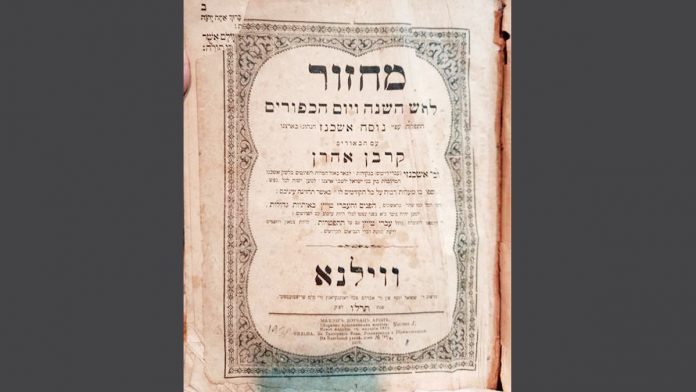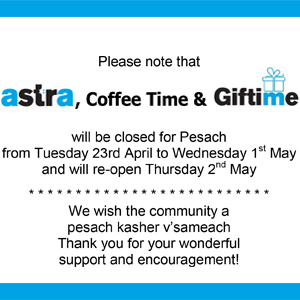By Tali Feinberg
This article first appeared in The South African Jewish Report, 12 Aug 2021
In a string of beautiful coincidences, a machzor that was printed in Yiddish in Vilna in 1876 has resurfaced in Cape Town just before the high holidays.
Not only that, but the address of the owner is written inside, and it’s the same address that now houses a section of Cape Town Torah High (CTTH).
“The book was given to me by Peter Greenberg. He found it in a box of old Jewish books belonging to his late grandfather,” says Rabbi Levi Silman, who collects old books and connected the dots between the machzor’s owner and CTTH’s address. “In this collection, some weren’t in good condition, some were sent to be buried, and some were given to charity. This was the only one of the very old books that was still intact.”
When opening the machzor, Silman noticed that the owner had written his name, J. Dick, and his address: 29 Maynard Street. The address jumped out at Silman, because his daughter attends CTTH, and that address is part of the CTTH Girls Campus where she spends much of her school day. Finally, the machzor was back in its original home.
Shlomo, the principal of CTTH, says he was “really amazed” when Silman told him about the machzor, and “the fact that it came to him of all people”, who is a parent at the school, with a daughter studying in that precise schoolhouse, made it all the more meaningful. Part of the school curriculum is learning the meaning and structure of the High Holiday prayers, but now the students know they are doing it in the exact same spot as another child many decades ago, whose primary language was Yiddish.
He shared the discovery with pupils in the very house where it had originally been located. “They were blown away. It’s surreal that there’s a connection to this house. We rent the house from the City as part of our campus, and we never knew it had any Jewish history. This machzor made us aware of that. It looks like the machzor was given as a gift, possibly to a child, as there is also a child’s handwriting and even doodling in it.”
They plan to make some kind of display box to hold the machzor, which is very fragile. Leila Bloch of the Jewish Digital Archive Project at the South African Jewish Museum confirmed that it is “a very rare find”.
Meanwhile, Greenberg says, “I had an old suitcase filled with Jewish books which were in my grandfather’s possession which I gave to Rabbi Silman. My grandfather was well known in the area, but I cannot say how he came to be in possession of this machzor. However, I recall that my maternal grandparents, Major Jacob Potashnik and Penina Potashnik, were friendly with the Dicks. My grandparents lived in Buxton Avenue in Oranjezicht. I asked an old family friend if she could remember anything about the Dicks. She couldn’t remember their first names, but said that they had a daughter, Leonie, and that they also lived in Buxton Avenue. I cannot say whether this Dick family is the same as the one who lived in Maynard Street.”
The coincidence is even more meaningful as CTTH is based in and around the former Ponevezh Shul — a tiny beit midrash that was the spiritual home to the small number of Jews who came to Cape Town from that shtetl in Lithuania, escaping Nazi destruction. In fact, this week, CTTH learners commemorate the annihilation of the Ponevez Jewish community during the Holocaust.
“The Jews of Ponevez were taken out of the city and killed between the first and the fourth of Elul,” Shlomo says. “The shul was established a year before that happened by relatives who had fled Europe.”
“The Ponevez community in Lithuania was known as a centre of great Torah learning and produced some of the greatest works of law and literature,” CTTH founder Sheila Valentini told the SA Jewish Report. “The entire community was massacred by the Nazis in 1941. The memory of these martyrs is now fortified by young Jewish adults learning Torah in a synagogue that’s named after them at the tip of Africa.” In addition, the distance between Vilna (where the machzor was published) and Ponevezh is only 130km.
This isn’t the first time that Valentini has come across a Jewish coincidence. She started the first CTTH class at her dining room table in Fresnaye, Cape Town. Soon after she moved out of that house, the driveway was dug up. “A community member was walking past and noticed that underneath each brick was an engraved Magen David,” she says.
The fact that the school landed up finding its first home in a synagogue was also meaningful, as the Ponevez Shul memberership was dwindling and the school occupying the building gave it new life. Now, the shul is in its best shape yet as it was recently restored by a school family in honour of a mother and grandmother who passed away within two days of each other from COVID-19 last year.
The school has come a long way since those dining room table classes in 2013, and now has “an unconventional campus” that has expanded to four school houses around Ponevez Shul, and boasting sixty pupils. The school anticipates close to seventy pupils in 2022, and is working on securing yet another schoolhouse on the street.
“We’ve never wanted to move, as we love the shul, the central location, and the proximity to Herzlia where our students can attend extra murals,” Shlomo says. As they have grown, everything has fallen into place. For him, the connections and coincidences are a glimpse into “divine providence, reiterating that we are exactly where we are meant to be. It’s like a little pat on the back from G-d, reinforcing that we are in the right place, doing the right thing.”
Cape Town Torah High www.cttorahhigh.org
• Published in the PDF edition of the September 2021 issue – Get the PDF here.
• Sign up for our newsletter and never miss another issue!
• Please support the Cape Jewish Chronicle with a voluntary Subscription. For payment info click here.
• Visit our Portal to the Jewish Community to see a list of all the Jewish organisations in Cape Town with links to their websites.
Follow the Chronicle: Facebook | Instagram | Twitter | LinkedIn











